Rat nests, burrows, bite marks, property damage, and fecal matter are forcing one Adams Morgan resident and her spouse to consider moving their lives out of D.C.
“The last two years, it really has felt like the rats and the trash have been such a bummer. It was never like that when I originally moved into D.C.,” the AdMo resident said.
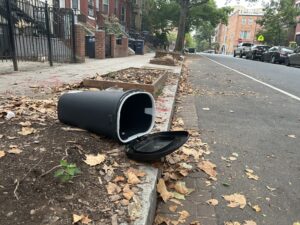
The couple spends most of their days in Virginia because rats have infested their Adams Morgan property. The couple asked to remain anonymous to protect their privacy.
The rats have chewed through chicken wire, nails, plywood, and steel to create a nest beneath their property, the AdMo resident said. The rodents also destroyed a wooden enclosure built to cover the property’s water and gas line, she said.
Apart from the property damage, the AdMo resident said the couple is constantly cleaning rat feces. Before the explosion of rats in Adams Morgan, the resident said they would deep-clean the patio every six months; now they are cleaning it as frequently as every two weeks.
“We are constantly cleaning. There are other things I’d rather do on a weekend than sweep rat feces off the patio,” said the AdMo resident.
This couple’s experience illustrates the frustration of many Adams Morgan residents. These residents say they started noticing a growing rat problem about two years ago, yet, despite filing multiple 3-1-1 service requests and reaching out to the Department of Public Works, City Council, the D.C mayor’s office, and Rodent and Vector Control, the rats continue to plague Adams Morgan’s streets.
D.C. health inspectors respond daily to 3-1-1 requests sent to the Rodent and Vector Control Division, and each is handled within three business days. There are 18 licensed pest control inspectors, each assigned to different wards in D.C., according to an official statement from D.C. Health Public Affairs Specialist Robert Mayfield.
These 3-1-1 requests are non-emergency service requests that D.C. residents can file to government agencies online, on the mobile app, or by phone, according to DC.gov. The Department of Public Works and the Health Department’s Rodent and Vector Control Division receive these requests.
However, Rodent and Vector Control doesn’t always fulfill these promises, said Commissioner Katherine Swanson of ANC 1C09.
“Sometimes I’ll get a great response from them and they’ll fix the problem. Sometimes I will never hear anything, and then my 3-1-1 ticket gets closed, and it doesn’t seem like anything actually happened,” said Swanson.
The AdMo resident said she remembers submitting a 3-1-1 request to Rodent and Vector Control, and 30 minutes later, the agency closed her ticket because the ground was “saturated.”
However, the AdMo resident said she doesn’t remember any rainfall that day. “It was mind-blowing to get a dismissal that quickly,” she said.
“Why is it my responsibility to then also track the weather, know when it’s okay for them to come out, and do treatments. I’m not a pest control specialist,” said the AdMo resident.
Rodent and Vector Control declined a formal interview and did not respond to specific questions sent by The Wash.
When did the rats get here?
D.C. has the fastest-growing rat population in North America, outranking cities like San Francisco, Toronto, and New York City, according to a study led by ecologist Johnathan Richardson.
The pandemic may have catalyzed the increasing rat population, Gerard Brown, program manager of Rodent and Vector Control, wrote on a Feb 11 WAMU Radio Facebook Post.
People stayed at home, leading to consistent food waste, leading to a “rat baby boom,” Gerard said.
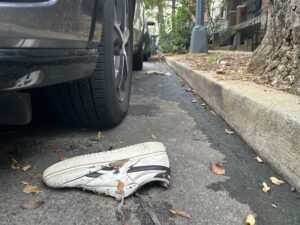
Residents and the Public Works mismanage trash, leaving bulk items, litter, and food waste in the streets, according to residents and Commissioner Swanson. Swanson and residents are in constant communication with Rodent and Vector Control, Public Works, the D.C. mayor’s office, and City Council, but little has been done to solve the problem, Swanson said.
“It’s important to note that, like, there are a lot of agencies that are doing things they are supposed to do,” said Swanson. “But no one seems to be able to figure this out, and I don’t know why.”
Communication pitfalls between agencies and residents
Swanson said that holes in the communication process between government agencies make rat and trash mitigation nearly impossible.
Although City Council members and staff are very responsive to the commissioner’s requests, they typically forward concerns to the Department of Public Works, according to Swanson. She said this is where emails “go to die.”
“They [City Council members and staff] just don’t seem to have any other, you know, helpful next step for me beyond ‘we will forward this email and try to help you follow up.’”
Ariel Ardura, director of the Council’s Committee on Public Works and Operations, told The Wash that the City Council has trouble contacting Public Works. She said the agency is missing “key roles” that helped “interface with the conflict.”
Recently, Public Works lost their chief administrative officer who acted as the public facing side of Public Works. Ardura said this could have something to do with contact issues.
There is some “cross-agency collaboration” between D.C. Health’s Rodent and Vector Control Division and the Department of Public Works to mitigate the rat issue, according to Ardura.
Audley Feemster, sanitation supervisor of Public Works’ Night Litter Can Operations, directed The Wash to Public Works representatives who could speak on inter-agency communication, but they did not return calls for comment. D.C. Health declined an interview.
When The Wash asked Ardura if the residents, Rodent and Vector Control, City Council, or Public Works are responsible for mitigating the rat issue, she said “all of the above.” Ardura said everyone must take steps to alleviate the rat problem, but some factors are difficult to control.
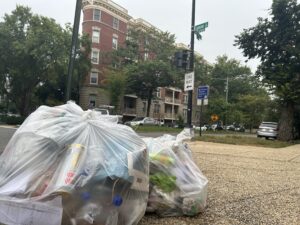
“I think it’s just a big city, lots of trash, and, you know, maybe some lack of awareness among residents about how to sort of properly handle waste. That does contribute somewhat to the problem for sure,” said Ardura.
Feemster said educating the general public is important, but not exclusive to mitigating waste issues. Stiffer fines, penalties, collaboration with agencies, and cracking down on illegal dumping are necessary to improve the Adams Morgan streets, according to Feemster.
Rats and Trash are inseparable: It’s time to take responsibility
A myriad of improper trash disposal and management habits have plagued Adams Morgan over the past few years, from illegal dumping, to other miscellaneous circumstances where trash is left to rot, according to Swanson.
Illegal dumping includes littering and leaving large bulk trash items in the street, according to the Department of Public Works official website.
“Talking about trash is important not just cause it’s gross but because it really is what’s causing the rat problem to be a problem,” said Swanson.
Swanson shared with the Wash an ongoing two-year email chain where residents started notifying government agencies about illegal dumping behind the Meridian Hill apartment complex on Ontario Road.
Frustrations escalated when a resident sent a follow-up email to agencies in May, highlighting the evolution of illegal dumping and the growth of rat infestations behind the apartment complex since the email chain began in 2023. Grievances included lidless overflowing trash cans, bulk items and garbage dumped onto the ground, active rat nests, construction waste, and abandoned furniture.
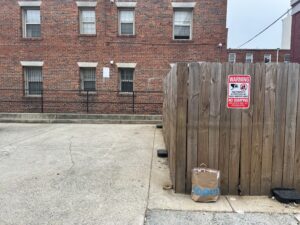
Supervisory Code and Rodent Inspector Andre Pittman notified residents that Rodent and Vector Control sent a $6,000 fine to the property owners in May, the email chain showed. Residents responded in June that the situation hadn’t improved since the fine.
Illegal dumping escalated in Adams Morgan when Public Works uninstalled two public litter cans last year due to “abuse,” according to Swanson.
Feemster defines “abuse” as placing household trash and commercial bulk items in and beside the public litter cans. If a public litter can is abused too often, it can be taken away.
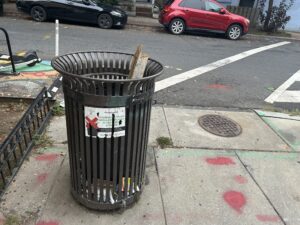
“I’ll be frank with you, it feels really backwards to me,” Swanson said. “It’s better in the trash cans than on the street because right now it’s just going straight on the curb.”
Feemster said that adding more public litter cans isn’t the solution. “It’s just giving uneducated individuals another place to dump their debris [illegally],” he said.
Although Feemster has concerns about adding more public litter cans, Mayor Muriel Bowser signed the City Council’s CLEAN Collections Act on Jan. 16, which would require Public Works to place public litter cans in residential areas that are adjacent to commercial areas, according to Ardura.
The act goes into effect tomorrow, Oct. 1.
When The Wash asked Swanson what she thought about the CLEAN Collections Act, she said she’s skeptical it will happen.
“It would have been helpful for [the Department of Public Works], to mention that one time, or any of the times that we asked them about, public litter cans,” said Swanson.

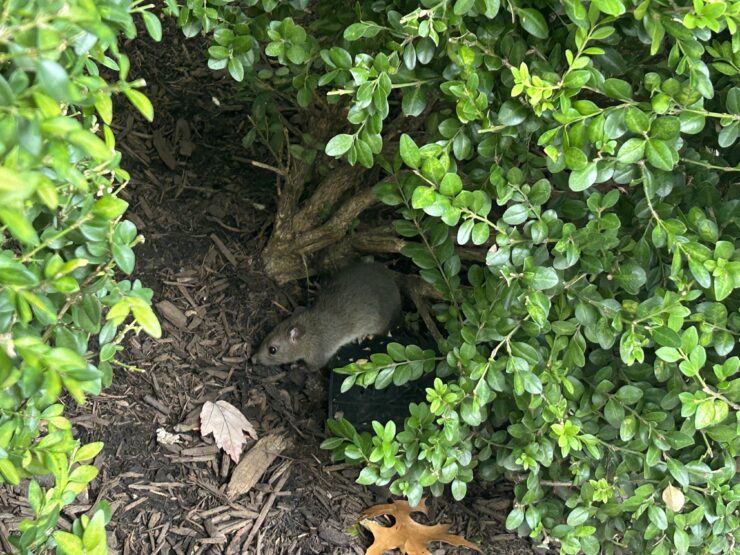
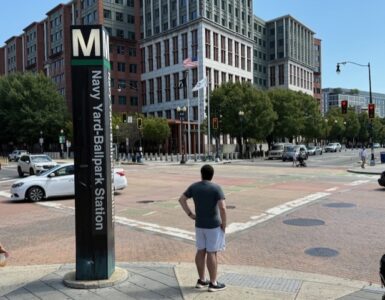

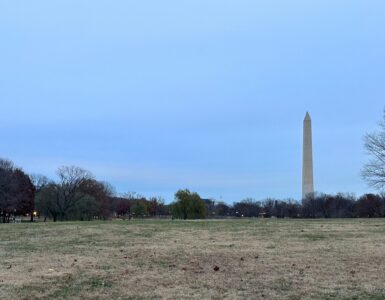










Add comment